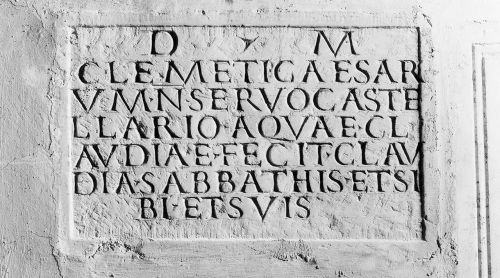#castellarius
Marble slab from the family tomb of a castellarius
The inscription reads:
D(is) M(anibus) / Cleme(n)ti Caesar/um n(ostrorum) / servo caste/llario aquae Cl/audiae fecit Clau/dia Sabbathis et si/bi et suis
The deceased, Clemens, controlled the distribution tanks (castella) of the Aqua Claudia (initiated by Caligula in 38 and completed by Claudius in 52), mentioned in the epigraph of the arches (now Porta Maggiore) incorporated in the Aurelian Walls (the final part of a 69 km path fed by springs from the upper valley of the River Aniene). The massive water system that served the capital of the Empire, described in a monograph by Frontinus, alone offers an indication of the magnificence of the city, divided into 14 regions and filled with fountains and thermal baths. Clemens was buried by his wife who bears, alongside a name of Semitic origin (Sabbathis), the same family name as Claudius. Perhaps the deceased (referred to generically as “slave of our Caesars”) belonged to this emperor and others who succeeded him rather than to the two co-reigning emperors: Marcus Aurelius and Lucius Verus (161-169 A.D.), M. Aurelio and Comodo (177-180 A.D.) or Septimius Severus and Caracalla (198-209 A.D.).
From Rome, unknown burial monument
Second half of the first – late second century A.D.
© Roma, Musei Vaticani, Galleria Lapidaria
Post link

